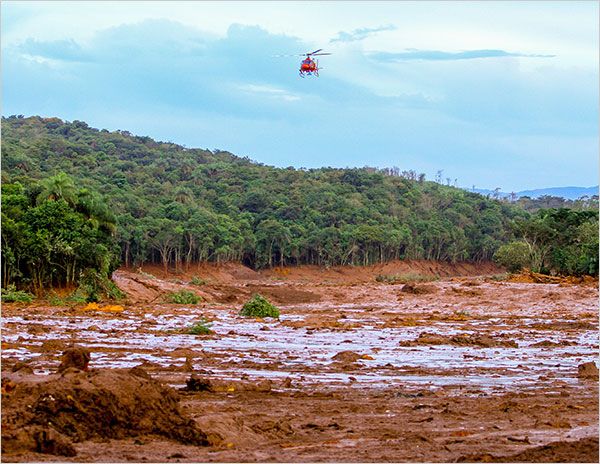
When looking at some of the biggest mining disasters that have impacted host communities – some clear themes emerge that give me some hope that they can be reduced.
Unfortunately, many mining company CEOs seem to focus on the costs of these events – the loss of output, the fines, the reputational damage and the crashing share price. But far away from the boardrooms of New York, Vancouver and London these events have a very real impact on people’s lives.
The human cost
One of the most recent of these disasters was the breach of the Brumadinho tailings dam on 25 January 2019 in Brazil. The resultant mudflow is estimated to have killed around 270 people as it swept all before it including houses, farms, commercial premises and even the mine’s headquarters. Disturbingly, this followed on the Mariana dam bust in November 2015, which claimed the lives of 19 people and destroyed the village of Bento Rodrigues. Both involved Vale & BHP subsidiaries.
On the other side of the world, the Ok Tedi Mine run by BHP in Papua New Guinea saw a dam failure in the 1980s, which resulted in vast amounts of toxic waste reaching the nearby river system. This contaminated water caused widespread deforestation and long-term damage to local fisheries and farmland.
And the list goes on…
Meanwhile, local communities accused Newmont Mining of dumping mercury and arsenic waste at Buyat Bay in Indonesia causing widespread health and economic harm.
Tahoe Resources' Escobal Mine in Guatemala also ran into problems as the indigenous people who had spiritual ties to the area were not properly consulted before the mining began. Peaceful protests against the mine soon escalated into violence with Guatemala’s Constitutional Court eventually suspending mining operations due to a lack of local consultation.
More recently there was the First Quantum Minerals’ copper mine in Panama, which sparked national protests over a mix of concerns ranging from political clientelism to environmental damage. The latter is somewhat ironic as copper is key to the renewables revolution, which is supposed to save us from a hydrocarbon fueled climate catastrophe. Nonetheless, the mine project ended up being suspended by a court order.
Corporate vandalism
In an act reminiscent of the Taliban defacing ancient Buddhist monuments in Afghanistan a quarter of a century ago - in 2020 Rio Tinto destroyed 46,000-year old Aboriginal rock shelters in Western Australia to expand an iron ore mine. This act was met with widespread public revulsion.
What’s particularly disturbing is that some of these cases took place only in the last five to seven years. Have the mining executives involved not learned anything from steadily steepening penalties and public opprobrium?
What they have in common
Upon studying these cases, it is clear most of the failures stem from some form of management failure – whether negligent or deliberate.
Basically, there was either a lack of engagement with communities or proper respect for their rights. Not enough thought was given to project designs (to minimise negative impacts on communities) and issues such as health and safety. Much of it was probably motivated by ignorance or cost cutting.
For example, with the Brumadinho disaster, the sensors that were supposed to monitor the tailing dam’s structural integrity had problems, which Vale knew about, but never got around to addressing until it was too late. With Mariana there was an absence of proper evacuation and contingency plans making rescue efforts for trapped villagers much harder.
Bitter lessons
If we are to draw a silver lining from all this misery, it is that most of it was preventable. That is of course shocking, but it does offer hope for the future. It means the suffering inflicted on host communities can be greatly reduced by ethically minded managers who prioritise the wellbeing of local people and mine workers.
And the public and governments are becoming less tolerant of bad behaviour.
Big fines and even prison sentences are becoming very real risks for callous and careless mining executives. The Brumadinho dam disaster, for example, cost Vale $7 billion in settlements and the incident sent the company’s share price plunging by nearly a quarter wiping away $19 billion in shareholder value.
Just as importantly a growing cohort of institutional investors are screening mining companies for unethical behaviour. Others simply chose to avoid the sector altogether not wanting to risk being tainted by any potential wrongdoing. And it's the financial sector that holds the financial purse strings.
That’s the stick.
Rewarding responsibility
The carrot for responsible mining companies is that they can become more accepted and even respected by society at large, which confers many rewards. These can include a clean reputation, easier access to capital, more opportunities to cement ties with industrial buyers and greater trust among host governments who award licences and the local communities who live next to these mines.
I do believe that despite recent setbacks, the mining industry is improving, and companies at the forefront of these efforts should be recognised and rewarded.
I leave you with this saying by the Roman writer Publilius Syrus: "A good reputation is more valuable than money."
